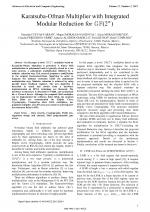| 2/2013 - 1 | View TOC | « Previous Article | Next Article » |
| Extra paper information in |
| Click to see author's profile in |
| Download PDF |
Author keywords
data security, cryptography, public key, algorithm design and analysis, field programmable gate arrays
References keywords
karatsuba(12), systems(6), reconfigurable(6), ofman(6), efficient(6), multipliers(5), multiplication(5), reduction(4), parallel(4), multiplier(4)
Blue keywords are present in both the references section and the paper title.
About this article
Date of Publication: 2013-05-31
Volume 13, Issue 2, Year 2013, On page(s): 3 - 10
ISSN: 1582-7445, e-ISSN: 1844-7600
Digital Object Identifier: 10.4316/AECE.2013.02001
Web of Science Accession Number: 000322179400001
SCOPUS ID: 84878919037
Abstract
In this paper a novel GF(2m) multiplier based on Karatsuba-Ofman Algorithm is presented. A binary field multiplication in polynomial basis is typically viewed as a two steps process, a polynomial multiplication followed by a modular reduction step. This research proposes a modification to the original Karatsuba-Ofman Algorithm in order to integrate the modular reduction inside the polynomial multiplication step. Modular reduction is achieved by using parallel linear feedback registers. The new algorithm is described in detail and results from a hardware implementation on FPGA technology are discussed. The hardware architecture is described in VHDL and synthesized for a Virtex-6 device. Although the proposed field multiplier can be implemented for arbitrary finite fields, the targeted finite fields are recommended for Elliptic Curve Cryptography. Comparing other KOA multipliers, our proposed multiplier uses 36% less area resources and improves the maximum delay in 10%. |
| References | | | Cited By |
Web of Science® Times Cited: 2 [View]
View record in Web of Science® [View]
View Related Records® [View]
Updated 2 weeks, 5 days ago
SCOPUS® Times Cited: 4
View record in SCOPUS® [Free preview]
View citations in SCOPUS® [Free preview]
[1] High performance AES-GCM implementation based on efficient AES and FR-KOA multiplier, Zhang, Yong, Wu, Ning, Zhou, Fang, Zhang, Xiaoqiang, Zhang, Jinbao, IEICE Electronics Express, ISSN 1349-2543, Issue 14, Volume 15, 2018.
Digital Object Identifier: 10.1587/elex.15.20180559 [CrossRef]
[2] High-performance optimization of SM4-GCM based on FPGA, Lv, Shun Sen, Li, Bin, Chen, Xiaojie, Zhou, Qinglei, 2021 International Conference on Advanced Computing and Endogenous Security, ISBN 978-1-6654-2449-3, 2022.
Digital Object Identifier: 10.1109/IEEECONF52377.2022.10013330 [CrossRef]
[3] Design of N-Term Scalable High-Performance Modular Multiplication Operator on GF (2m), Zhang, Benjun, Wu, Ning, Zhou, Fang, Ge, Fen, Fei, Caixian, 2021 IEEE 4th International Conference on Electronics Technology (ICET), ISBN 978-1-7281-7673-4, 2021.
Digital Object Identifier: 10.1109/ICET51757.2021.9451142 [CrossRef]
[4] An Area-Efficient SM2 Cryptographic Engine for WBAN Security Enhancement, Pei, Hongzhe, Wang, Gang, He, Guanghui, 2023 6th International Conference on Electronics Technology (ICET), ISBN 979-8-3503-3769-3, 2023.
Digital Object Identifier: 10.1109/ICET58434.2023.10212039 [CrossRef]
Disclaimer: All information displayed above was retrieved by using remote connections to respective databases. For the best user experience, we update all data by using background processes, and use caches in order to reduce the load on the servers we retrieve the information from. As we have no control on the availability of the database servers and sometimes the Internet connectivity may be affected, we do not guarantee the information is correct or complete. For the most accurate data, please always consult the database sites directly. Some external links require authentication or an institutional subscription.
Web of Science® is a registered trademark of Clarivate Analytics, Scopus® is a registered trademark of Elsevier B.V., other product names, company names, brand names, trademarks and logos are the property of their respective owners.
Faculty of Electrical Engineering and Computer Science
Stefan cel Mare University of Suceava, Romania
All rights reserved: Advances in Electrical and Computer Engineering is a registered trademark of the Stefan cel Mare University of Suceava. No part of this publication may be reproduced, stored in a retrieval system, photocopied, recorded or archived, without the written permission from the Editor. When authors submit their papers for publication, they agree that the copyright for their article be transferred to the Faculty of Electrical Engineering and Computer Science, Stefan cel Mare University of Suceava, Romania, if and only if the articles are accepted for publication. The copyright covers the exclusive rights to reproduce and distribute the article, including reprints and translations.
Permission for other use: The copyright owner's consent does not extend to copying for general distribution, for promotion, for creating new works, or for resale. Specific written permission must be obtained from the Editor for such copying. Direct linking to files hosted on this website is strictly prohibited.
Disclaimer: Whilst every effort is made by the publishers and editorial board to see that no inaccurate or misleading data, opinions or statements appear in this journal, they wish to make it clear that all information and opinions formulated in the articles, as well as linguistic accuracy, are the sole responsibility of the author.



